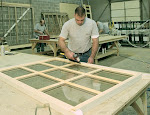The other day, I was shopping for my daughter’s 16th
birthday present, which dictated that I visit stores like Forever 21 and H
& M so I’d have half a chance of selecting something she would actually
wear. While I was browsing through the
stores with throngs of female “tweens”, I was amazed at the incredibly cheap
design of the clothing. Virtually
everything in those stores is designed to make it through one season. I’ve purchased rags at Home Depot that are
made of better material. Its pretty
obvious that apparel marketers are selling fashion rather than durability. This made me think about how the same trend toward
marketing inferior products is beginning to dominate much of US industry
including construction materials. I
decided to delve into this topic to see if I could determine what is causing
this disturbing trend.
Why is the quality of clothing, electronics, appliances,
building materials, automobiles, etc. on the decline? The answer turns out to be more complex than
just blaming greedy US manufacturers, outsourced Chinese fabricators, or the
sluggish economy. There happens to be
several factors that are driving this development. Although the deterioration of quality has
affected all industries, I’ll focus on the factors that seem to be shaping the
construction industry.
Just as rapidly changing styles are driving the clothing
industry to use materials that only last one season, the construction industry
is also a slave to fashion. Look at the
rapidly changing designs of appliances, lighting fixtures, furniture, and
plumbing fixtures. Interior finish
colors, floor covering, and hardware finish frequently change based upon
consumer preferences and what’s trendy at the time. It’ll be a sad day when granite countertops
and stainless steel go out of style, because kitchens across the country are
going end up in the landfill. This
rapidly changing style influences manufacturers to design products with only a
ten year lifespan. There is no need to
design a shower head to last more than ten years if it’ll be replaced in eight. That stainless steel refrigerator is designed
for a seven year lifespan since it will be replaced by white enamel in the next
decade. Manufacturers are designing their products to perform for the fashion
lifecycle rather than focusing on enduring quality.
Another element that contributes to the decline in product
quality of the construction industry is the speedy development of new
technologies. Innovative technologies have had a big impact on the sales of
appliances, windows, wood alternatives, lighting, home automation, and home
entertainment. There is no need to design kitchen appliances that will last for
two decades if consumers are going to exchange them for Wi-Fi enabled products
that can be controlled with a smartphone as soon as the technology presents
itself. Why would a manufacturer waste
resources designing a durable product if it is going to become obsolete with a
technological change? Consumers are paying for new technologies, not for
products that will last for a lifetime.
Another contributor to diminished quality in construction
products is the mindset of the American consumer. The typical American has been conditioned by advertising
media for his/her entire life. Thousands
of advertising messages play every day and reinforce how Madison Avenue wants
us to think and behave. The typical
American consumer has become a sucker for the media. The hypnotic effect of the advertising
machine convinces the populace that happiness can be found in a new living room
sectional. We are well trained to
appreciate the sizzle rather than the steak.
We want new stuff, and we want it to be inexpensive. So manufacturers
have responded by providing low-cost products using inferior materials like
laminates, plastics, and substandard metals.
Where manufacturers used to be focused on building a better quality
mousetrap, they are now designing to meet a price point. So when you hear someone say, “They don’t
building them like they used to,” you only have yourself to blame.
Finally, many markets in the construction industry are very
mature and have succumbed to a commodity status. Product design has matured to the point where
there is only minor differentiation between manufacturers. Take a look at the window business for
example. There are very few differences
between one US manufacturer and another.
They use the same glass, wood, aluminum, finish, weather strip, and
hardware. They achieve the same results in a battery of performance tests. In an effort to compete, these manufacturers
have scurried to cut costs in materials, manufacturing, and distribution. The result is a host of manufacturers that
produce mediocre quality products at a minimum cost to the company. I represented one manufacturer for many years
that had an edict to cut 10% of their costs every year for four years
straight. Although they gained a
competitive advantage in pricing, they lost the quality that originally made
the company a success.
Given the influences outlined above, there is going to be an
influx of material heading to the landfill over the next couple of decades. I believe there is a big opportunity for companies
to design and manufacture quality products that double or triple the current
lifecycles. Re-View has been successful
in occupying a small niche market that demands a 100 year lifecycle window,
which proves there is demand for quality products. I think there is a nascent trend that
recognizes the positive impact of increasing product lifecycles, but until that
trend catches on across the board, I’ll have to settle for purchasing this
T-shirt that looks nice but will probably fall apart after five wash
cycles.






No comments:
Post a Comment